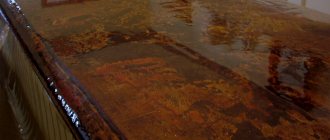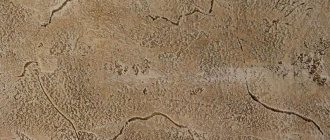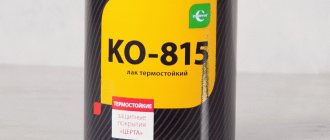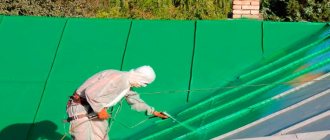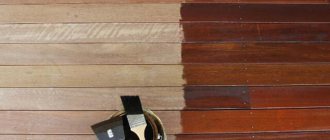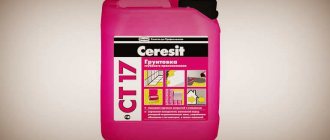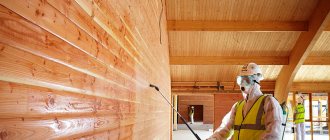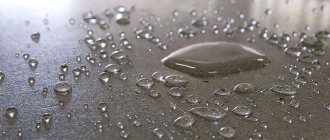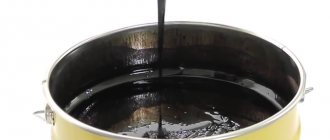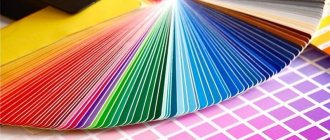Features of stone varnish
High-quality paints and varnishes must have increased strength and wear resistance.
But for a material such as concrete, they must contain a number of other characteristics:
- Since concrete surfaces can have a significantly larger area, it is desirable that the varnish is applied quickly, easily and is convenient to use. This would significantly reduce the time and increase the efficiency of repair work.
- The product must provide a strong and wear-resistant coating; it must reliably protect the material from various damages.
- The versatility of the product will not be superfluous. Ideally, it should be suitable not only for concrete surfaces, but also for brick and stone.
Protective varnishes are used strictly following the manufacturers' recommendations. If all application rules are followed, the products will reliably strengthen the concrete surface from slow but inevitable destruction.
Help chemicals
Both natural and artificial stone are susceptible to corrosion, destruction, moisture and many other external factors. It often develops salt stains or rust stains. Removing them is difficult, but there is a way out. Granite, porcelain stoneware, gypsum and gypsum products can be coated with a special hydrophobic impregnation, sometimes with a silicone base. It will protect surfaces from moisture, rapid destruction and staining.
If stains have already appeared, you can use rust removers. All these substances have a protective and decorative function. For example, treating marble with impregnation makes marble products strong, reliable and durable, and also protects against rust and other stains.
Scope of application of stone varnish
Varnishes for concrete are produced for both external and internal work. They are often used for surfaces and objects such as:
- Floors, walls, ceilings;
- Fences and other barriers;
- Garden paths, bridges, sidewalks;
- Buildings, parking lots, blind areas;
- Street screeds, various concrete products, elements, compositions.
Types of varnish for stone
There is a wide range of paint and varnish products on the market. They all have a different base, and their composition is filled with different components.
Polyurethane
Varnishes containing this substance have good moisture resistance characteristics.
For this reason, they are often used in areas such as:
- Baths,
- Saunas,
- Bathrooms and showers.
Polyurethane varnishes are also suitable for outdoor use, where they are actively used to treat swimming pools, paths and sidewalks.
Polymer
This component is responsible for the strength and durability of the coating. Polymer-based varnishes dry quickly, and working with them is easy and convenient, because they are quickly and well applied to the concrete surface.
Acrylic
Provides moisture resistance, makes the coating strong and reliable. Having a high price category, acrylic varnishes are often used for finishing small planes, elements and various decorative works.
Silicone
This substance gives the product excellent ability to repel water. Silicone varnishes, for the same reason as acrylic ones, are used mainly for interior work with small parts and for varnishing individual elements and products.
Epoxy resins
Varnishes containing resin are resistant to chemicals and various mechanical damage.
Varnishes for concrete surfaces come in glossy, matte, semi-matte and semi-gloss.
In rooms with high traffic, it is more advisable to use matte and semi-matte varnishes. Scratches and various types of damage are less visible on surfaces treated with them.
Glossy and semi-gloss varnishes are used mainly to create decor and visually increase space. Glossy surfaces are easy to care for and can be easily cleaned from dust and other contaminants.
How to use impregnation
As you know, impregnations are used for various purposes, for example, to protect facade tiles, shell rock and sandstone, as well as lime surfaces. In any case, you should know the technique for applying these products:
- The first thing to do is prepare the base, which must be cleaned of dirt, dust and debris. It is advisable to apply hydrophobic impregnation for stone using a brush, sponge and roller. In this case, the air temperature must be at least 11 degrees and the humidity more than 67%.
- Once the base is prepared, you can begin applying the mixture. This must be done evenly.
- Next, you should prevent any moisture from coming into contact with the treated surface for 13-14 hours. After applying the solution, the stone will have better water-repellent properties only after 38 hours, which then, according to manufacturers, will last for 9-10 years.
- It is important to follow basic safety precautions when applying the product to your work surface. In particular, you need to wear rubber gloves to protect your hands and special glasses to protect your eyes. If the product gets on your hands, rinse them thoroughly with warm water.
- The remaining material cannot be stored after completion of the work; it must be disposed of.
Choosing a varnish for stone
To carry out varnishing work, the product should be selected, paying attention to the surface being treated, for example:
- Materials such as tiles, stone, brick should be treated with products that are resistant to temperature changes and have frost-resistant and moisture-repellent properties.
- The components included in such varnishes must ensure its durability, strength and wear resistance.
- For interior work on ceramic or stone surfaces, it is also important that the varnish has waterproof properties and the ability to protect the surface from mechanical damage.
- Using glossy varnishes you can create the effect of wet stone. This effect is a stylish trend in a modern interior.
- Surfaces treated with matte varnishes are able to absorb light, creating a soft, calm atmosphere in the room.
It is necessary to choose one or another varnish based on personal preferences and tastes. But it is also necessary to take into account both the composition of the surface being treated and the location of the varnishing work.
Types of protective drugs
Impregnation must be selected taking into account the negative effects that will be exerted on the stone during operation. Today, chemical manufacturers offer different types of impregnations. The composition fills the pores and does not allow moisture to destroy the natural material.
In addition, the stone becomes resistant to gasoline, salt, chemicals and other aggressive substances and retains its attractive appearance for many years.
Depending on the composition, protective impregnations are of the following types:
Rules and recommendations for application
When carrying out paint and varnish work, do not neglect protective equipment. Gloves, goggles and a respirator are essential items when working with synthetic substances. For greater safety, it is important to ensure good ventilation in the room.
Before starting work, you must carefully inspect the surface. If there is any contamination, dust, small crumbs, then it is necessary to thoroughly clean and free the surface being processed from this debris.
- If the surface to be treated has a large area, then it is more appropriate to use a spray gun, the work will go much faster with it, and for varnishing small parts it is more advisable to use a brush.
- The mixture should be applied in several layers, this will help increase the strength and durability of the coating. Before application, make sure that the surface is dry and clean, this will help to achieve fast and high-quality work.
It is important to prepare the necessary tools in advance, and strictly following the instructions, begin to carry out paint and varnish work.
Operating rules
The application of hydrophobic agents follows some basic rules.
- Processing marble, granite, gypsum and gypsum products begins with cleaning their surface. They need to remove stains from oils, tar, bitumen, salt, and mold. Removal can be done using special cleaning products.
- Depending on the type of impregnation used, the working surface should be dry or wet. For example, silicone-based solutions require moisture for the reaction to begin.
- Corrosion of cement stone, as well as other types of stones, leads to the formation of cracks. They need to be sealed before covering the surface with a water repellent. For small cracks, it is enough to mix cement and sand. For larger ones, epoxy resin is suitable.
- Concrete products (this also applies to repaired cracks) must be cured for 4 weeks before coating.
- It is important to determine whether the materials and impregnation are compatible. For example, products for limestone, gypsum, granite or marble may differ in composition and principle of action. If there are any doubts regarding the use of a particular composition, a test application should be carried out.
- Under no circumstances should the impregnation be diluted or modified in any way. It must be applied from the container in which it is supplied by the manufacturer.
- Water repellents are applied with a roller or brush, or they can be sprayed.
- Apply impregnation in a thin layer. If there is any excess left, remove it immediately.
- It is important that the room in which work is carried out is well ventilated.
How to Remove Rust Stains
Sometimes rust may appear on the stone surface. How to deal with it? Using special cleaners. They come in two types:
Both rust removers are made on the basis of inorganic acids and anti-corrosion additives. Such cleaners are not suitable for stones that are damaged by acids, such as plaster and gypsum structures.
Marble materials
Marble processing is a separate issue. This natural stone has a heterogeneous structure, veins, inclusions, and cracks. Unlike granite, it is soft and easy to work with. These properties affect the durability of marble products.
To correct the situation, impregnation for marble is suitable. It is easily absorbed without leaving stains or streaks and without changing the appearance of the products. Such substances make marble more durable, moisture-resistant, and resistant to destructive factors.
